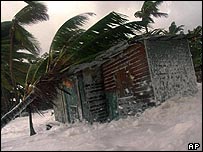
Hurricanes have also wrought devastation on a huge scale
|
The massive tsunami in the Indian Ocean has been described by relief experts as one of the worst natural disasters in recent history. With a likely death toll of well over 250,000, the wave is particularly notable for the extent of its reach, from Indonesia in the east, to the coast of Africa, some 7,000km (4,000 miles) away. The high numbers of Westerners affected and the speed at which footage from the disaster reached television screens also added to its impact. The highest death toll from a tsunami until now happened in 1896, when 27,000 people were drowned following an earthquake off the coast of Japan, according to the Guinness Book of Records. Cyclones and famine But there have been other natural disasters which have also claimed tens of thousands of lives. In 1970, up to 500,000 people were killed in Bangladesh when a cyclone whipped up winds of 230 km/h which swept away entire villages.
 |
NATURAL DISASTERS
2004 Asian quake disaster - toll so far exceeds 110,000
2003 earthquake in Bam, Iran - official casualty figure is 26,271
1976 Earthquake in Tangshan, China, kills 242,000
1970 Cyclone in Bangladesh kills 500,000
1923 Tokyo earthquake kills 140,000
1887 China's Yellow River breaks its banks in Huayan Kou killing 900,000
1896 Tsunami kills 27,000 in Japan
1815 Volcanic eruption of Mount Tambora on Indonesia's Sumbawa Island kills 90,000
1556 Earthquake in China's Shaanxi, Shanxi and Henan provinces kills an estimated 830,000
|
China suffered similar losses when an earthquake with a magnitude of 8.3 almost obliterated the north-eastern city of Tangshan in 1976. The official number of people killed was put at around 250,000, although some said the figure was more like 750,000. In 1984 and 1985, a famine in Ethiopia killed an estimated 900,000 people. Last year, a 6.3 quake devastated the Iranian city of Bam, killing 26,271, according to official figures. Hurricane Mitch, which devastated much of Honduras and Nicaragua in Central America in 1998, killed 10,000 people and left some two million homeless. The 1988 earthquake in Armenia, measuring 6.9, killed nearly 25,000. And one of the worst monsoons in living memory claimed the lives of 10,000 people in Thailand over the course of three months in 1983. Some 100,000 people contracted waterborne diseases as a result of the storm. Snow storms, forest fires and avalanches have all proved deadly. A single landslide in Peru in 1970 killed more than 18,000 people in the town of Yungay. In 1887, about 900,000 people died when the Yellow River in China burst its banks in the worst-ever recorded flooding. A volcanic eruption of Mount Tambora on Indonesia's Sumbawa island in 1815 claimed the lives of more than 90,000 people as a blanket of lava and ash covered all around it, leading to agricultural devastation, famine and disease. China's Shaanxi, Shanxi and Henan provinces lost an estimated 830,000 people when they were hit, in 1556, by one of the worst earthquakes in history.
|

~RS~q~RS~~RS~z~RS~36~RS~)

~RS~q~RS~~RS~z~RS~36~RS~)
Bookmark with:
What are these?